
Both the Toronto and Montreal auto shows could have been hampered by the absence of several major auto manufacturers, but journalists and the public weren’t dissuaded, as both events were very well attended. Montreal posted 148,000 paid visitors compared to the last “normal” show in 2020, when 184,000 people spun through the turnstiles. This was extraordinarily good attendance, considering Ford, Honda, Mazda, Stellantis (Jeep, Dodge and Chrysler), the German brands and Volvo, were absent. Although Stellantis was present in Toronto, the other brands also abandoned the Canadian International Auto Show (CIAS). Despite the absence of many major industry players, the Toronto show’s attendance figures were robust. Manufacturers who did not participate in either show missed a lot of eyeballs viewing their vehicles.
The Montreal Salon de l’auto is covered first with the CIAS following.
Lexus RZ 450e
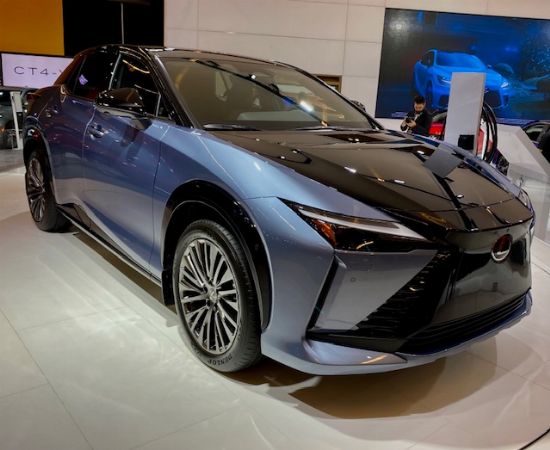
The first Lexus-branded battery electric vehicle (BEV), the RZ 450e is based on the Toyota bZ4X. With delivery times for the bZ4X quoted up to five years, the RZ 450e may itself become a public relations exercise rather than an actual car that will make its way into the hands of owners.
Built on the same wheelbase as the bZ4X and the related Subaru Solterra, the RZ 450e is a bit longer and wider and marginally lower. Power comes from a 71.4 kWh battery pack that sends power to front and rear-mounted motors to develop 308 total system horsepower. All-wheel drive is standard. The range has not been published.
Though it is based on the bZ4X, the RZ 450e shares no body panels with it. The lower air intake is flanked by panels that resemble the rear grilles on the legendary Lexus LFA supercar that debuted for 2011. The side profile of the RZ is a bit fussy, as is the rear. The cabin is more visually serene. The dashboard features a massive infotainment screen like the ones on the Lexus NX and RX models. The controls appear to be easier to maniupulate than the awful trackpad that plagued Lexus owners in the past. The cabin relies more on form than applied ornament and looks very Zen.
Hyundai 7 Concept Car
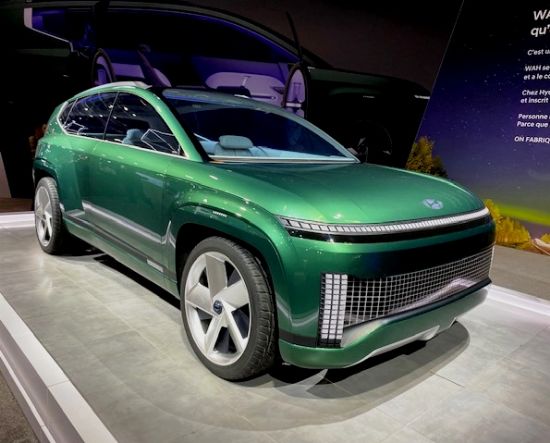
Most Hyundai concept cars make it into production within a year or so after being unveiled, and the 7 should be no exception.
The 7 is built on Hyundai’s Battery Electrice Vehicle (BEV) architecture. No mechanical details were released but power units and output should mirror those of the Ioniq 5. The 7 looks clean and purposeful with little extraneous ornamentation. Entry is eased by 1930s-style pillarless doors with rear-hinged rear doors, that permit a completely unobstructed opening when all four doors are open. Inside, the 7 is essentially a mobile luxury lounge. The vehicle is technically a three-row SUV, but the seating configuration on the show car was unusual. There is a driver’s seat in the traditional spot and also a passenger-side seat that looks to be deployable in the front or middle row. A large, L-shaped couch begins as a conventional third-row bench that curves around to extend the bench toward where a conventional second row seat would be located. The cabin looks very luxurious and is clad in exotic materials like mineral plaster and bamboo wood and carpeting.
Hyundai Ioniq 6
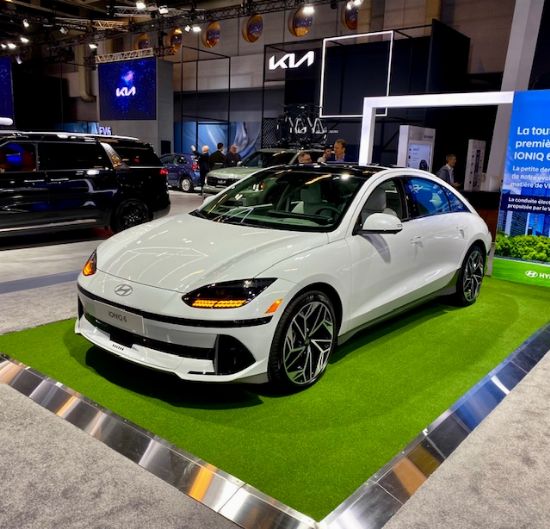
The new Ioniq 6 sedan shares Hyundai’s E-GMP electric car platform that underpins the Hyundai Ioniq 5, Genesis GV60 and the Kia EV6.
At 2950 mm, the Ioniq 6’s wheelbase splits the difference between the 3000 mm wheelbase of the Ioniq 5 and the 2900 mm wheelbase of the Kia EV6 and Genesis GV60. Preliminary information indicates all trims will be powered by a 77.4 kW battery pack which will send power to either the rear wheels, or optionally, to all wheels. The motor on the base car puts out 225 horsepower (168 kW) and drives the rear wheels. All-wheel drive features a 165 kW rear motor and a 74 kW front-mounted motor, with a combined rating of 320 horsepower. Published ranges are 547 kilometers for the rear-wheel drive car, with 499 kilometers for the dual-motor all-wheel drive model. The car can be charged from 10 to 80 percent in 18 minutes using a Level III charger.
Styling is dramatic and attractive but (the shape is a homage to the Porsche 911, in a sedan body) hardly original. With a low coefficient of drag of .22, the body is very slippery. Inside, the driver faces a computer tablet similar to the Ioniq 5’s, with a “vehicle” sector in front of the driver and an “infotainment” section over the centre of the dash. Conventional interior handles adorn each door but the door pulls are cleverly recessed, and still get the job done. The vertical surfaces of the upper door trims bear a subtle horizontal ribbed motif, with linen-patterned hard plastic areas on much of the rest of the door. Low-contrast, two-tone cabin hues complete the visually clean interior. Headroom is tight, especially in the rear, and while rear seat legroom is good, the very low-mounted front seats prevent rear seat riders getting their feet under the front seats, reducing real-world, accessible legroom.
New-generation Kia Niro
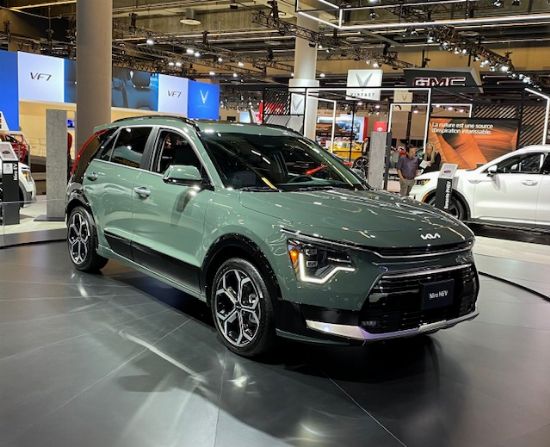
The Montreal Salon was the first Canadian showing of the new-generation Kia Niro. The car will once again be offered in HEV (hybrid), PHEV (plug-in hybrid) and BEV (battery electric vehicle) variants.
Built on the same wheelbase as before, the new-generation Niro is 64 mm longer overall and marginally wider. The HEV twins a 1.6L four with an electric motor to create 139 horsepower and 195 lb.ft. of torque. The PHEV also employs the 1.6L engine, coupled with an electric motor to furnish 180 total system horsepower and 195 lb.ft. of torque. The 11.1 kWh battery pack has 55 kilometres of pure electric range and recharges in three hours on a Level II charger. Both the HEV and PHEV power the front wheels via a six-speed dual clutch automated manual transmission.
The BEV uses a 64.8 kWh battery pack that powers a 150 kW electric motor. Range is stated to be 407 kilometers, about 20 percent greater than last year. The battery pack can be recharged to 80 percent in 43 minutes hooked up to a Level III charger.
The new Niro moves past the rounded, amorphous form of its predecessor to something with more of a hint of modern VW about it. Overall, it comes off as tasteful and contemporary but a touch anodyne. Some models will be available with a contrasting paint band between the rear door and the tailgate. Like many contemporary cars, all car-operation readouts and infotainment functions are handled by a computer tablet. The rear seat is a bit oddly shaped and not totally welcoming, and legroom is less than expected. Cargo space is square and deep below the window line.
2024 Subaru Impreza
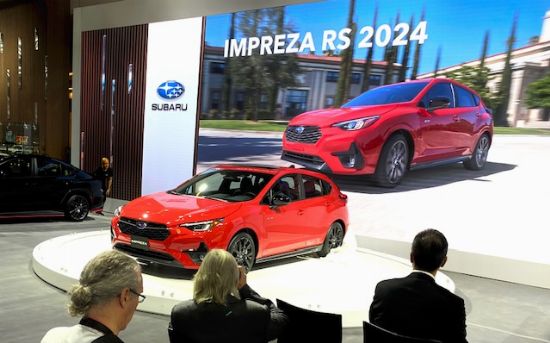
Like many new Subarus, styling changes are so subtle that few people will notice. As with the last Impreza, the new one is built on the Subaru Global Platform revised in a way that results in 10 percent higher torsional rigidity. Wheelbase and all other key dimensions are the same.
The 2024 Impreza loses its manual transmission but gains a 2.5L engine option for those who select the new RS trim.
Subaru’s Eyesight Safety system has a wider field of view and better detection capability for 2024, and is said to react more quickly to pedestrians and cyclists. Models with blind spot and rear cross traffic monitors also gain an auto emergency steering function as well.
Inside, the new Impreza uses the dashboard first seen on the 2023 WRX. The driver faces a conventional gauge package much like the 2023 model. The centre of the dash loses its eyebrow sunshade and now features a giant, vertically-oriented screen that controls all functions. The climate controls are clearly visible in the screen and don’t need to be accessed via various menu screens. The rest of the cabin resembles its predecessor, with a number of components unchanged from 2023. Cabin and cargo space are the same as before. Subaru claims seating is more supportive than previously and the seats of the RS model on display were sumptuous. The iOS-Android cellphone interface is now wireless. The 2024 Impreza should be on sale by mid-2023.
Buick Wildcat concept car
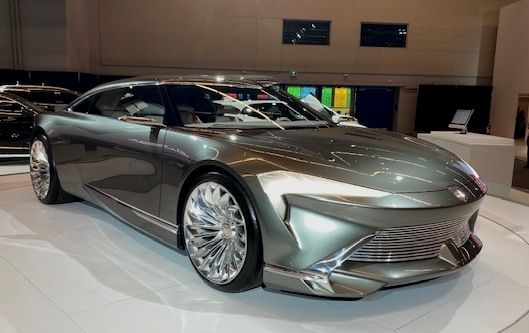
Buick has not built a passenger car in many years but this concept may signal an eventual return to the passenger car market. The Wildcat name was appended to the top Buick full-size car from 1963 to 1970. Mechanical details are unknown but it is assumed the Wildcat rests on GM’s versatile “Ultium” electric car architecture that is working its way through the GM lineup.
The Wildcat displays exaggerated show car features like massive wheels, cameras taking the place of conventional door mirrors and a super sumptuous cabin. That said, if the overall form of the car is a hint at Buick’s upcoming styling, we will be seeing some handsome new Buicks in the next few years.
New-generation Chevrolet Trax
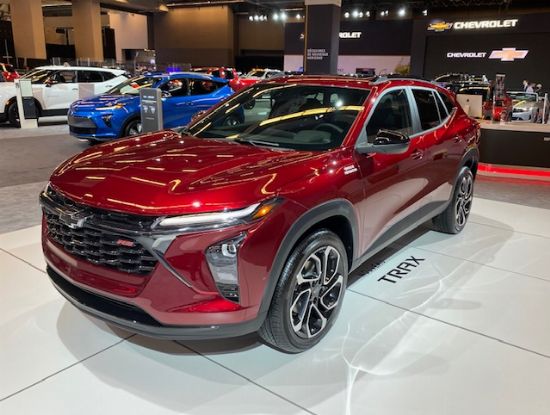
With a 145 mm longer wheelbase and 280 mm greater overall length, the 2024 Trax is significantly bigger than its predecessor and so big that it is essentially the same size as the more expensive Trailblazer. Perhaps only one of the nameplates will survive in the future.
Power stems from the same turbocharged 1.2L three-cylinder engine also found under the hood of the Trailblazer. It generates 137 horsepower and 162 lb.ft. of torque in this application. The small capacity engine makes sense for markets where cars are taxed for engine capacity, but seems senseless for North America where the complexity of the turbo will likely cause service issues for long-term owners.
The new Trax shares styling themes explored on the Blazer and Trailblazer and looks very contemporary. The audio system features an on-off-volume knob, while other functions are touch screen based. Climate control is handled by conventional knobs and buttons. The rest of the cabin is attractive but there are few soft-touch surfaces inside. Cabin and cargo space are ample.
2023 Chevrolet Colorado
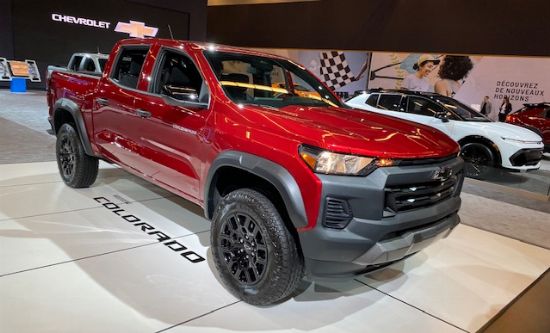
After eight years, GM has finally updated the Chevrolet Colorado and its companion, the GMC Canyon. So far, only a crew cab, short-box model has been announced. Only one engine, a gasoline 2.7L turbo four with three outputs, is offered on the Colorado, with only the top engine available in the Canyon. Power reaches the wheels via an eight-speed automatic transmission exclusively. The vast majority of variants of this platform feature 4-wheel drive. Standard active safety equipment on both trucks include forward collision warning, including for pedestrians, autonomous emergency braking, a lane departure warning and a lane keep assist system. The Google Assistant audio concierge is a new offering for 2023.
The new Colorado features very au courant, square-rigged styling that bears a resemblance to the full-size Silverado and Sierra pickups. The interior is more contemporary. The driver faces a TFT gauge package in a Camaro-esque, hooded, binnacle. The dash itself is a substantial, rectilinear, horizontally-arrayed styling element. The rear doors of the crewcab body style allow access to the rear seat but, despite the longer wheelbase, legroom in the rear seat is absurdly tight. GM has paid a lot of attention to increasing cargo-bed versatility. Like the innovative Ford Maverick, GM’s new pickup features 2×4 slots in the cargo bed to permit owners to fabricate their own cargo-locating solutions and offers a 45 degree tailgate open angle that can let longer items rest on the wheel wells and the partly open tailgate.

AJAC Car and Utility vehicle of the Year presentation
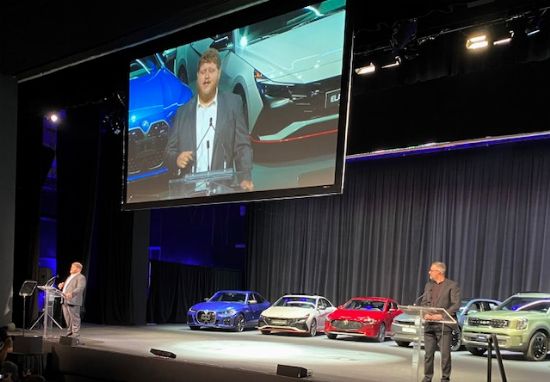
The Auto Journalists Association of Canada announced the Car and Utility Vehicle of the year awards at the 2023 Canadian International Auto Show (CIAS) Media Day. The winners were chosen by votes cast by AJAC voting members who attended the AJAC TestFest at Mosport raceway, in October 2022.
The Car of the Year was the all-electric BMW i4, winning over fellow category finalists, the Hyundai Elantra N and the Mazda 3. The Utility Vehicle of the Year was awarded to the all-electric Hyundai Ioniq 5, which beat out the Kia Telluride and Mitsubishi Outlander for the trophy.
Project Arrow is a test bed for Canadian auto suppliers
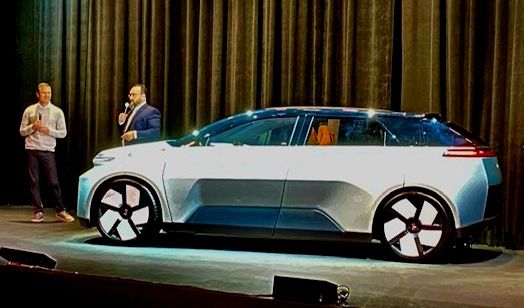
Project Arrow is a showcase vehicle meant to highlight the capabilities of Canada’s vehicle component suppliers. Around 50 Canadian suppliers combined to fashion the Project Arrow luxury crossover.
The vehicle is powered by an 82.5 kWh lithium-ion battery pack that powers a dual-motor all-wheel drive system. All aspects of the car, including its exterior and cabin styling, are Canadian.
Potential Motors Adventure 1 Off-Roader
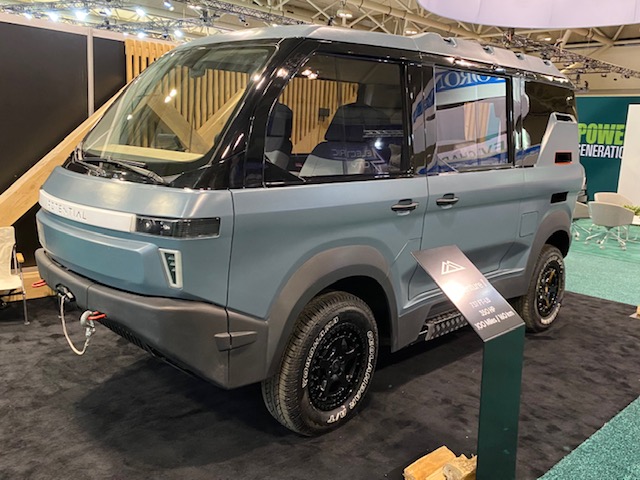
This New Brunswick built, all-terrain vehicle, is exclusive for off-road use. With a finite (but undisclosed) production ceiling and deliveries planned for 2025, the Adventure 1 will never be a market force but is a very interesting design. The vehicle seats four, sleeps two and it is equipped with an integrated kitchen with a propane stove, a fridge and a sink that can be filled from the 40L on-board water storage tank.
The Adventure 1 is fully electric, with its lithium-ion battery pack creating 350 horsepower, 737 lb.ft. of torque and 160 kilometers of off-road range. Power reaches all four wheels via a dual motor setup. The drive components are attached to each end of a very robust tubular platform, with the battery pack nestled under the floor.
The Dodge Hornet is an upscale crossover
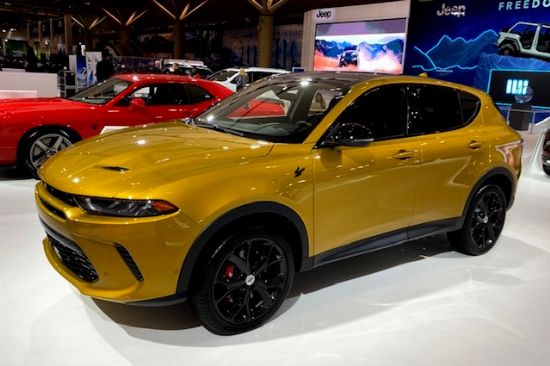
Dodge introduced an upscale compact crossover that recycles the Hornet name that was initially fastened to a Hudson in the 50s and an AMC car in the 70s. The car is built at the Stellantis factory at Pomigliano d’Arco, near Naples, that was originally built to assemble the Alfa Romeo Alfasud.
The Hornet shares the same wheelbase and structure with the Alfa-Romeo Tonale (and Maserati Grecale) and is marginally longer overall than the BMW X1. Two engines will be offered. The GT is powered by a 268 horsepower 2L turbo four that is used in various Stellantis vehicles, with the R/T PHEV combining a 1.3L turbo four with an electric motor to generate 288 total system horsepower. The 15.5 kWh battery pack can travel up to 50 kilometers in pure electric mode. All-wheel drive is standard, with the rear wheels of the PHEV being driven electrically. Both powertrains feature a Sport mode; the PHEV adds Hybrid, Electric and E-Save settings. The PHEV is equipped with Brembo brakes and Koni shock absorbers.
The front of the Hornet displays a slender grille that rests above a massive lower air intake, and looks very Dodge. The cabin looks very European and is fashioned from some attractive materials. Seating is comfortable front and rear, and legroom is good in both rows. The trunk is regularly shaped and deep below the window line. Deliveries should begin this spring.
2024 Subaru Crosstrek
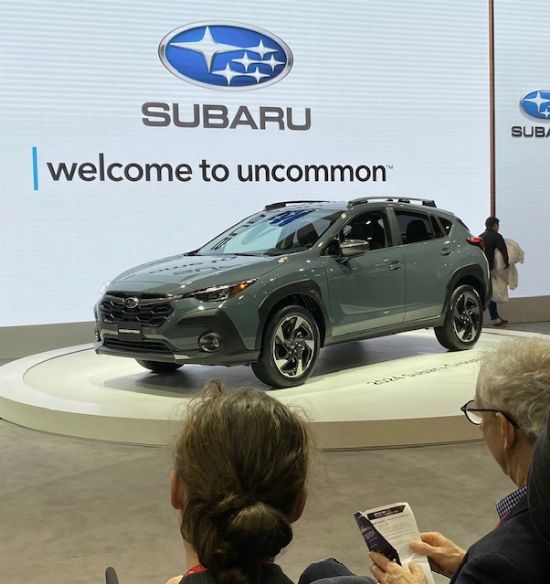
Subaru unveiled the 2024 Crosstrek, which is a spin-off of the Impreza it had presented earlier in Montreal.
The Crosstrek receives the same updates as the Impreza, such as a structure with 10 percent greater torsional rigidity, a new dashboard featuring Subaru’s massive, vertically-oriented touch screen incorporating all infotainment and climate functions, softer seats, an enhanced Eyesight system and an electric brake booster. The 2L and 2.5L flat fours return, as does the CVT automatic, which becomes the sole transmission on offer for 2024.
The Crosstrek has been a massive success for Subaru in Canada, outselling the Impreza, the car on which it’s based on, by a significant margin. Deliveries should begin this summer.
Cobble Beach Concours D’Elegance 75 Years of Porsche
Held in September north of Owen Sound, Ontario, the Cobble Beach Concours has participated at the CIAS for several years. This year’s display this year exhibited a variety of significant Porsche models.
1952 Porsche 356 Pre-A
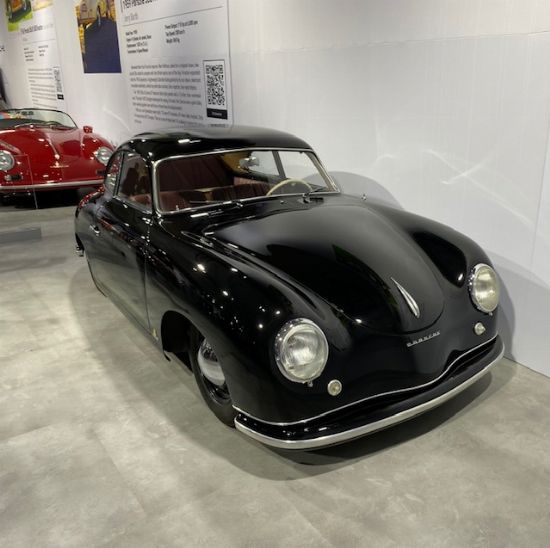
The 356 was the first Stuttgart-built production Porsche. The Pre-A designation is for 356 models built between 1950 to 1955, before the significant 1956 update, which included a larger 1.6L engine and a new moniker, the 356A. This car was subject to a three year restoration.
1970 Porsche 911 ST Lightweight
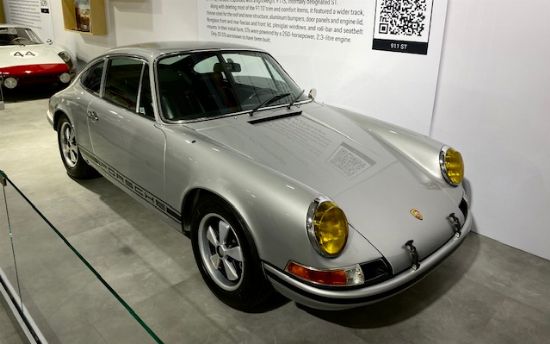
The 911 ST was Porsche’s response to the Federation Internationale de l’Automobile (F.I.A.) creation of a new Group 4 Special GT production sports car class in 1970. It employed various weight-reduction measures, including replacing glass with plexiglass, thinner steel for the roof and inner structure, alloy doors, rear deck lid and bumpers, and fibreglass bumpers and hood.
This 1970 model is powered by a 250 horsepower 2.3L flat-six that sent power to the rear wheels via a five-speed manual transmission.
1984 Porsche 928 S
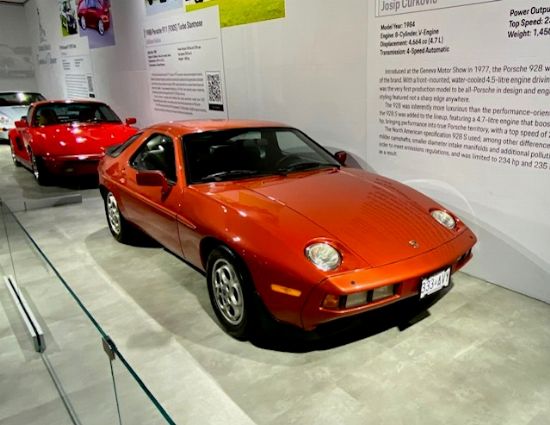
The 928, the first Porsche design that broke free from the rear-engine layout, debuted for the 1977 model year. This front-engine rear-drive layout was never fully-embraced by Porsche sports car fans.
The 928 was powered by a front-mounted, water-cooled, 4.7L-V8 engine that sent power to the rear wheels. This model, a 928 S, was built in 1984. The 4.7L-V8 in this car is rated at 234 horsepower and sends its power to the wheels via a four-speed automatic transmission.
1996 Porsche 911 Turbo
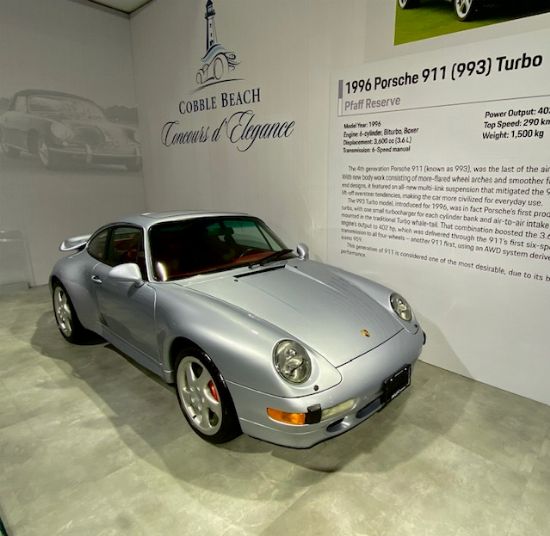
The last of the air-cooled 911s, its twin-turbocharged 3.6L flat-six is rated at 402 horsepower and sends power to all four wheels via a six-speed manual transmission. Late model air-cooled 911s were almost instantly collectible when the automaker switched to water cooled engines in 1997.
